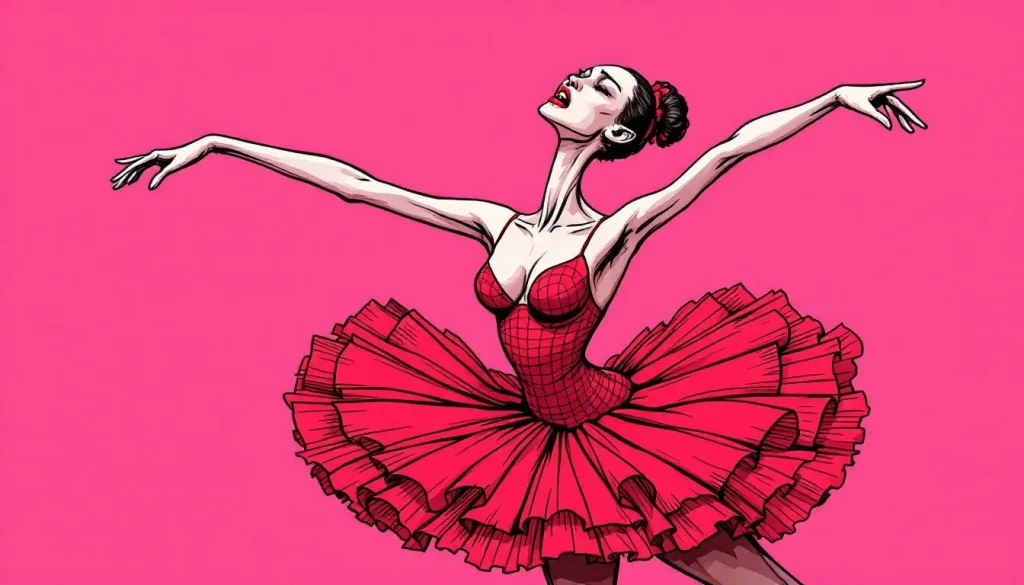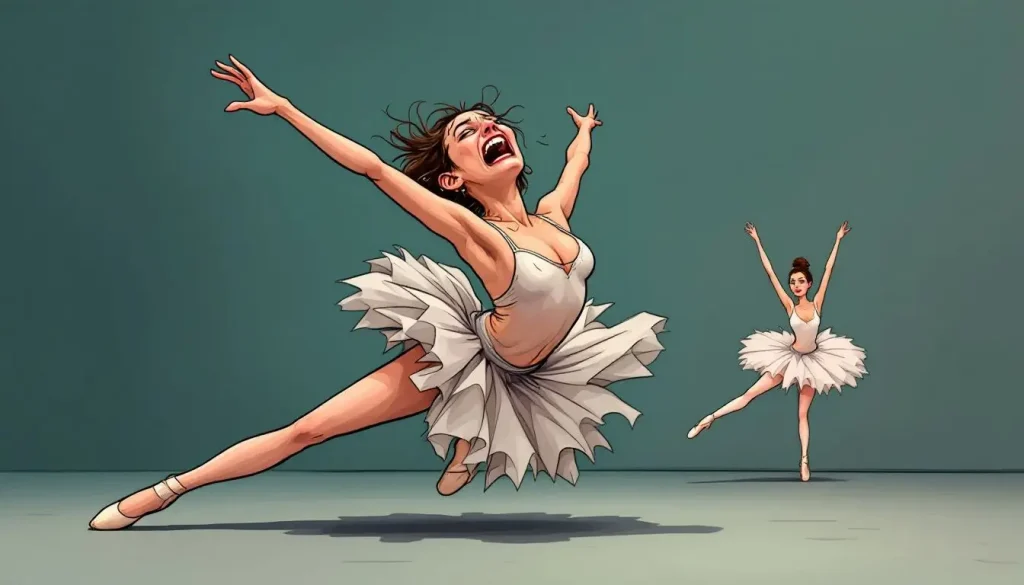While beautiful, ballet comes with hidden costs. Discover why ballet is bad as we examine its physical toll, impact on mental health, and the unrealistic body ideals it enforces on dancers.
Key Takeaways
- Ballet culture enforces unrealistic body standards, leading to high rates of body dissatisfaction and disordered eating among dancers.
- The physical demands of ballet contribute to chronic injuries, particularly due to the overuse of pointe shoes and inadequate attention to dancers’ well-being.
- Intense competition and pressure in ballet significantly impact mental health, resulting in high levels of performance anxiety and depression, which call for improved support systems within the dance community.
Ballet Is Bad Podcast
| Reason | Explanation | Potential Risks/Outcomes |
|---|---|---|
| Physical Injuries | Repetitive, high-impact movements and extreme joint positions can lead to acute or chronic injuries. | Stress fractures, tendonitis, sprains, strains, overuse injuries, and joint damage. |
| Pointe Work | Dancing en pointe places unnatural stress on the feet and ankles. | Bunions, blisters, stress fractures, toe and nail damage, and long-term foot deformities. |
| Body Image Issues | Pressure to maintain a certain body type can negatively impact self-esteem and mental health. | Eating disorders, anxiety, depression, body dysmorphia. |
| Delayed Growth & Development | Intensive training during adolescence can affect growth, puberty, and bone health. | Delayed puberty, menstrual irregularities (female athletes), and reduced bone density. |
| Psychological Stress | High-performance expectations and competitive environments can cause significant stress. | Burnout, performance anxiety, depression, and social withdrawal. |
| Career Longevity | Ballet careers are often short due to the physical demands. | Early retirement, lack of long-term job security, and transition challenges. |
| Joint Hypermobility | Ballet encourages extreme flexibility, which can destabilize joints over time. | Increased risk of dislocations, chronic pain, and joint instability. |
| Financial Insecurity | Professional ballet often offers low pay and limited opportunities. | Financial stress, limited access to healthcare, and job precarity. |
| Lack of Diversity & Inclusion | Traditional body and aesthetic standards can exclude or marginalize some dancers. | Exclusion, discrimination, and reduced opportunities for diverse talent. |
| Long-Term Health Effects | Decades of intense training can impact the body even after retirement. | Arthritis, chronic pain, and mobility issues in later life. |
Unrealistic Body Standards in Ballet

The ballet community often imposes unrealistic body standards, leading to significant physical and mental health challenges for dancers. Ballet culture celebrates extreme thinness, perpetuating outdated ideals that contribute to body image issues and mental health concerns among dancers. These body concerns and pressures are particularly pronounced among professional ballet dancers, who face intense scrutiny regarding their body shape from peers, instructors, and media portrayals. Dancing ballet can improve body satisfaction and confidence, but it also exists alongside the pressure to maintain an ideal body shape, especially in professional settings.
In the following subsections, we’ll explore the specific pressures to lose weight, disordered eating habits, and their impact on self-esteem.
Pressure to Lose Weight
The ballet world is hyper-competitive, with immense pressure to lose weight. Media often emphasizes unrealistically thin body types, distorting young dancers’ self-perception. This competition can lead to harmful practices aimed at maintaining a perceived advantage, contributing to significant body image issues. About 50% of ballet dancers are dissatisfied with their bodies, highlighting the widespread impact.
Disordered Eating Habits
Disordered eating habits are alarmingly prevalent in the ballet community. More than 16% of ballet dancers are reported to have eating disorders, with the most common being EDNOS (eating disorder not otherwise specified). The competitive nature within ballet companies fosters an atmosphere that promotes unhealthy behaviors like restrictive eating and body shaming.
Breaking eating restrictions often leads to guilt and anxiety among dancers, exacerbating mental health disorders.
Impact on Self-Esteem
Idealized body standards in ballet profoundly affect dancers’ self-esteem. Young dancers frequently encounter media that glorifies thin body types, negatively impacting their self-image and contributing to mental health concerns at a young age. This pressure can significantly affect dance technique and undermine their confidence and well-being.
Physical Strain and Injuries

The physical demands of ballet are immense, leading to a high incidence of musculoskeletal injuries among dancers. Ballet significantly strains dancers’ bodies, particularly their feet and ankles, which are prone to various injuries. The competitive nature of ballet can create an environment where dancers feel pressured to push through pain, exacerbating these physical health challenges.
In the next subsections, we’ll discuss chronic injuries, the overuse of pointe shoes, and the long-term physical health consequences of ballet training.
Chronic Injuries
Repetitive movements in ballet often lead to chronic injuries. Conditions like tendonitis and stress fractures are common, especially in the Flexor Hallucis Longus. The physical intensity and commitment expected from professionals result in higher injury rates than recreational dancers.
Overuse of Pointe Shoes
Ballet classes significantly increase the risk of foot and ankle injuries due to the added pressure of dancing en pointe. Female dancers are particularly vulnerable to conditions like flexor hallucis longus tendinopathy and plantar fasciitis. Overusing pointe shoes leads to severe foot and ankle issues, highlighting the physical demands of classical ballet training.
Long-Term Physical Health
The long-term physical health consequences of a ballet career are significant. Many dancers suffer from chronic injuries like tendonitis, stress fractures, and flat feet due to extensive training and performing. This strain can have lasting effects on their overall well-being.
Mental Health Challenges

Ballet dancers often face significant mental health challenges due to the intense pressures of life in the ballet industry. The focus on an extremely thin physique and the culture of perfection can lead to anxiety, depression, and other mental health concerns.
We’ll explore performance anxiety, depression among dancers, and the need for support systems within the dance community in the next subsections.
Performance Anxiety
Performance anxiety is a common issue among ballet dancers. Symptoms like nausea and rapid heartbeat can be debilitating, affecting their ability to perform under pressure. Many dancers experience this anxiety due to fears of not meeting high standards set by themselves and others.
Depression Among Dancers
Depression is a significant mental health challenge faced by professional ballet dancers. Approximately 20.8% of dancers exhibit moderate symptoms of depression, with higher rates observed in female dancers compared to their male counterparts.
These high rates underscore the need for enhanced mental health support within the ballet community.
Support Systems
Addressing the mental health needs of ballet dancers requires robust support systems. Approximately 26.9% of dancers seek assistance from mental health professionals, highlighting gaps in current support systems within the ballet community.
The Role of Ballet Teachers

Ballet teachers influence dancers’ physical and mental health in ballet schools. Their teaching methods and feedback can significantly affect students’ self-perception and well-being.
We’ll discuss the impact of teaching styles, the balance between encouragement and criticism, and the importance of teacher training in the next subsections.
Teaching Styles
Ballet instructors’ teaching styles profoundly shape dancers’ experiences and body perceptions. Many dancers internalize feedback about their weight, feeling compelled to alter their bodies to align with perceived standards, contributing to negative self-esteem and mental health issues.
Recognizing these impacts is vital for fostering a healthy environment for dancers.
Encouragement vs. Criticism
Balancing encouragement and criticism is crucial in ballet training. Supportive feedback, paired with constructive criticism, helps cultivate a positive learning environment and fosters self-esteem.
This balance is essential for the well-being and development of ballet dancers.
Teacher Training
Training programs for ballet instructors increasingly recognize the importance of mental health awareness. Equipping ballet teachers with mental health awareness enables them to foster a nurturing environment and effectively address students’ emotional challenges.
Coping strategies, such as focusing on positive thoughts and practicing breathing exercises, can help mitigate performance anxiety.
Ballet Culture and Its Impact

Ballet culture has a profound impact on dancers’ well-being. The unique pressures associated with the profession, including high expectations and a competitive environment, often lead to significant mental health issues.
We’ll explore the competitive environment, media representation of other dancers, and the tension between tradition and modernization within ballet in the next subsections.
Competitive Environment
The competitive nature of ballet fosters an environment where dancers constantly compare themselves to others. This scrutiny and pressure can lead to unhealthy behaviors, including disordered eating and negative self-image, among dancers.
Media Representation
Media representation often amplifies unrealistic body standards in ballet, leading young dancers to develop negative self-image and body dissatisfaction. These pressures can result in disordered eating habits and significant self-esteem issues.
Tradition vs. Modernization
Traditional practices in ballet emphasize unrealistic body standards that are detrimental to dancers’ well-being and artistic expression. Different teaching styles can reinforce these traditional practices or promote healthier body image and self-esteem approaches.
Equipping ballet teachers with mental health awareness is crucial for fostering a more supportive environment.
Comparing Recreational and Professional Dancers
The experiences of recreational and professional dancers differ significantly regarding body image, physical demands, and mental health. Recreational dancers often experience higher body satisfaction and lower stress levels than professionals.
We will explore these differences in more detail in the next subsections.
Recreational Dancers’ Body Image
Recreational ballet dancers experience greater body satisfaction than most ballet dancers and professional ballet dancers. Studies show they report more satisfaction with their bodies than gym-goers, elite athletes, and sedentary women.
With an average BMI of 20.9, recreational ballet dancers indicate a healthier body image than the general population.
Physical Demands
Professional dancers engage in more frequent and intense training sessions, leading to higher levels of physical strain and chronic injuries. Recreational dancers face lower physical demands, allowing greater flexibility in their training schedules and a lower risk of injury. A professional dancer must navigate these challenges carefully.
Mental Health in Non-Professional Settings
Mental health concerns manifest differently in non-professional ballet settings. Recreational dancers may experience lower performance anxiety and stress levels, allowing for a more enjoyable dance experience.
However, they may not everyone still faces unique mental health challenges related to community dynamics and personal fulfillment.
Resume
The hidden harms of ballet on dancers’ well-being are multifaceted, encompassing unrealistic body standards, physical strain, and mental health challenges. Ballet teachers play a critical role in shaping dancers’ experiences, while the overall ballet culture continues to impact their well-being. By recognizing these issues and advocating for healthier practices, we can create a more supportive and nurturing environment for all dancers. Let us embrace the beauty of ballet while promoting the health and well-being of those dedicated to this demanding and beautiful art form, too.
Frequently Asked Questions
What are the main physical health challenges faced by ballet dancers?
Ballet dancers primarily contend with musculoskeletal injuries, chronic conditions like tendonitis and stress fractures, as well as long-term issues such as flat feet. These challenges stem from the rigorous physical demands of their art form.
How does the media influence body image among ballet dancers?
The media significantly influences body image among ballet dancers by promoting unrealistic thinness and physical attributes, which results in distorted self-perception, body dissatisfaction, and increased risk of disordered eating habits. This portrayal creates immense pressure on dancers to conform to these ideals.
What mental health challenges are common in the ballet community?
Mental health challenges common in the ballet community include performance anxiety and depression, largely stemming from the intense pressures and high standards of the industry. It is crucial to address these issues to support the well-being of dancers.
How can ballet teachers impact the well-being of their students?
Ballet teachers can greatly enhance their students’ well-being by providing a balanced approach of encouragement and constructive feedback while being trained in mental health awareness to create a supportive atmosphere. This holistic teaching style positively affects their students’ physical and psychological health.
How do the experiences of recreational ballet dancers differ from those of professional dancers?
Recreational ballet dancers typically experience higher body satisfaction and encounter lower physical demands and performance anxiety, in stark contrast to professional dancers who face rigorous training and significant mental health challenges.
What are the most common injuries in ballet dancers?
Ballet dancers frequently experience overuse injuries such as stress fractures, tendinitis, and sprained ankles. These injuries often result from repetitive movements, intense training schedules, and the physical demands of techniques like pointe work.
How does ballet training affect mental health?
The high-pressure environment of ballet can lead to mental health challenges, including anxiety, depression, and perfectionism. Constantly pursuing excellence and critique can contribute to psychological stress among dancers.
Are eating disorders prevalent among ballet dancers?
Yes, the emphasis on maintaining a specific body image in ballet has been linked to a higher incidence of eating disorders such as anorexia and bulimia among dancers.
What nutritional challenges do ballet dancers face?
Dancers often struggle with maintaining adequate nutrition due to restrictive diets aimed at controlling weight. This can lead to deficiencies in essential nutrients like iron, calcium, and vitamin D, affecting overall health and performance.
At what age do most ballet dancers retire?
Many professional ballet dancers retire in their early to mid-30s due to the physical demands of the profession. The exact age can vary based on individual circumstances and career opportunities.
What challenges do dancers face when transitioning to a new career?
Transitioning from a ballet career can be emotionally and professionally challenging. Dancers may experience a loss of identity and community, and often need to develop new skills for alternative jobs.
How does the culture of perfectionism in ballet impact dancers?
The pursuit of perfection in ballet can lead to excessive self-criticism and stress. This culture may contribute to mental health issues and a fear of failure among dancers.
What role does cross-training play in a dancer’s regimen?
Cross-training, including Pilates and swimming, helps dancers build strength, flexibility, and endurance, reducing the risk of injury and improving overall performance.
How do financial factors affect ballet dancers’ well-being?
Many ballet dancers face financial instability due to low wages and short career spans. This economic pressure can add stress and impact their quality of life.
What support systems are available for retired dancers?
Organizations offer career counseling, educational grants, and support groups to assist dancers in transitioning to new professions after retirement from performance.
How does early specialization in ballet affect young dancers?
Starting intense ballet training at a young age can lead to physical strain and psychological pressure, potentially impacting growth and mental development.
What is the impact of ballet on dancers’ feet?
Ballet, especially pointe work, can cause foot injuries such as bunions, stress fractures, and tendonitis due to the unnatural positions and repetitive stress.
How does the competitive nature of ballet influence dancers?
The highly competitive environment can foster a sense of rivalry and pressure to outperform peers, which may lead to stress and burnout.
What are the psychological effects of performance pressure in ballet?
The constant need to perform flawlessly can lead to performance anxiety and fear of failure, affecting dancers’ mental health and confidence.
How important is rest and recovery for ballet dancers?
Rest and recovery are crucial for preventing injuries and maintaining physical and mental health. Overtraining without sufficient rest can lead to burnout and chronic injuries.
What measures can be taken to improve dancers’ mental health?
Implementing mental health support, promoting a positive training environment, and encouraging open discussions about psychological well-being can help improve dancers’ mental health.
How does body image perception affect ballet dancers?
The emphasis on a specific body type in ballet can lead to body dissatisfaction and unhealthy behaviors aimed at achieving the ideal physique.
What role do instructors play in dancers’ health?
Instructors significantly influence dancers’ physical and mental health through their teaching methods, feedback, and the creation of a training environment.
How can ballet institutions support dancers’ overall well-being?
Institutions can provide resources for injury prevention, mental health services, nutritional guidance, and career transition programs to support dancers holistically.
What are the long-term health implications of a ballet career?
Long-term effects can include chronic injuries, joint issues, and psychological impacts stemming from the intense physical and mental demands of a ballet career.







